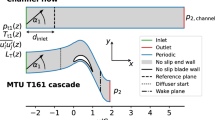Abstract
The prediction of the laminar to turbulent transition is essential in the calculation of turbine blades, compressor blades or airfoils of airplanes since a non negligible part of the flow field is laminar or transitional. In this paper we compare the prediction capability of the Detached Eddy Simulation (DES) with the Large Eddy Simulation (LES) using the high-pass filtered (HPF) Smagorinsky model (Stolz et al.[1]) when applied to the calculation of transitional flows on turbine blades. Detailed measurements from Canepa et al.[2] of the well known VKI-turbine blade served to compare our results with the experiments. The calculations have been made on a fraction of the blade (10%) using non-reflective boundary conditions of Freund at the inlet and outlet plane extended to internal flows by Magagnato et al.[3] in combination with the Synthetic Eddy Method (SEM) proposed by Jarrin et al.[4]. The SEM has also been extended by Pritz et al.[5] for compressible flows. It has been repeatedly shown that hybrid approaches can satisfactorily predict flows of engineering relevance. In this work we wanted to investigate if they can also be used successfully in this difficult test case.
Similar content being viewed by others
References
S. Stolz, P. Schlatter, D. Meyer and L. Kleiser (2003): High-Pass filtered Eddy-Viscosity Models for LES, Direct and Large-Eddy Simulation, V.R. Friedrich, B.J. Geurts and O. Metais, Eds. Kluwer, Dordrecht, pp. 81–88.
E. Canepa, A. Cattanei, F. Pittaluga, M. Ubaldi, P. Zunino (2003): Transitional boundary layer on the suction side of a turbine blade at different Reynolds numbers, Proc., 5th European Conference on Turbomachinery: Fluid Dynamics and Thermodynamics, Prague.
F. Magagnato, B. Pritz, M. Gabi (2006): Calculation of a Turbine Blade at High Reynolds Numbers by Large-Eddy Simulation. The 11th of International Symposium on Transport Phenomena and Dynamics of Rotating Machinery, Honolulu, Hawaii.
N. Jarrin, S. Benhamadouche, D Laurence and R. Prosser (2005): A Synthetic-Eddy-Method for Generating Inflow Conditions for Large-Eddy Simulations. Symposium on Hybrid RANS-LES Methods, Stockholm.
B. Pritz, F. Magagnato, M. Gabi (2006): Inlet Condition for Large-Eddy Simulation Applied to a Combustion Chamber. Conference on Modeling Fluid Flow (CMFF’06), Budapest, Hungary.
M. Ubaldi, P. Zunino, U. Campora., A. Ghiglione (1996): Detailed velocity and turbulence measurements of the profile boundary layer in a large scale turbine cascade, ASME Paper No. 96-GT-42.
V. Michelassi, J. G. Wissink, W. Rodi (2003): DNS, LES and URANS of periodic unsteady flow in a LP turbine cascade: a comparison, Proc., 5th European Conference on Turbomachinery: Fluid Dynamics and Thermodynamics, Prague.
D.K. Lilly (1967) The representation of small scale turbulence in numerical simulation experiments. Proc. IBM Sci. Computation Symp. On Environmental Sciences. Yorktown Heights, USA, 195–210.
J.P. Boris, F.E. Grinstein, E.S. Oran, R.L. Kolbe (1992): New insights into large-eddy simulation. Fluid Dyn. Res., 10: 199–228.
F. Magagnato et al. (2005) Transition Prediction on a Turbine Blade at High Reynolds Numbers by LES, Symp. on Hybrid RANS-LES Methods, Stockholm.
P. Schlatter (2005): Large-Eddy Simulation of the transition and turbulence in wall-bounded shear flow. Ph.D. Thesis No. 16000, ETH-Zurich.
P.R. Spalart, W.H. Jou M. Strelets and S.R. Allmaras (1997): Comments on the feasability ot the LES for wings and on the hybrid RANS/LES approach, In Advances in DNS/LES, 1st AFOSR International Conference On DNS/LES, Greyden Press, pp. 137–148.
F. Magagnato, (1998): KAPPA — Karlsruhe parallel program for aerodynamics, TASK quarterly, 2(2), pp. 215–270.
J.B. Freund, (1997): Proposed inflow/outflow boundary condition for direct computation of aerodynamic sound, AIAA-Paper 35(4), 740–742.
F. Magagnato, J. Rachwalski, M. Gabi (2003), “An application of the buffer layer technique to computations of flow in turbomachinery,” Proc., 12th International Conference on Fluid Flow Technologies, Budapest, Hungary.
P. Bradshaw (1977): Compressible Turbulent Shear Layers. Ann. Rev. Fluid Mech., 9: 33–54.
M. Germano (1992): Turbulence: The filtering approach, J. Fluid Mechanics, Vol. 238, 325–336.
A. W. Vreman (2003): The filtering Analog of the Variational Multi-scale Method in Large-Eddy Simulation, Physics of Fluids, 15., pp. L61–L64.
S. Stolz (2005): High-pass Filtred Eddy-Viscosity Models for Large-Eddy-Simulation of Compressible Wall-Bounded Flows. Transactions of the ASME, Vol. 127.
K. Shimizu, M. Kawamura, (1972): Spanwise correlation measurement behind circular cylinder in subcritical Reynolds number, Journal Physical Society Japan, 32, pp. 1454.
J. Smagorinsky (1963): General Circulation Experiments with the primitive Equations. Mon. Weather Review, 93, pp. 99–164.
Author information
Authors and Affiliations
Rights and permissions
About this article
Cite this article
Magagnato, F., Pritz, B. & Gabi, M. Calculation of the VKI turbine blade with LES and DES. J. Therm. Sci. 16, 321–327 (2007). https://doi.org/10.1007/s11630-007-0321-x
Received:
Issue Date:
DOI: https://doi.org/10.1007/s11630-007-0321-x




